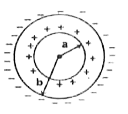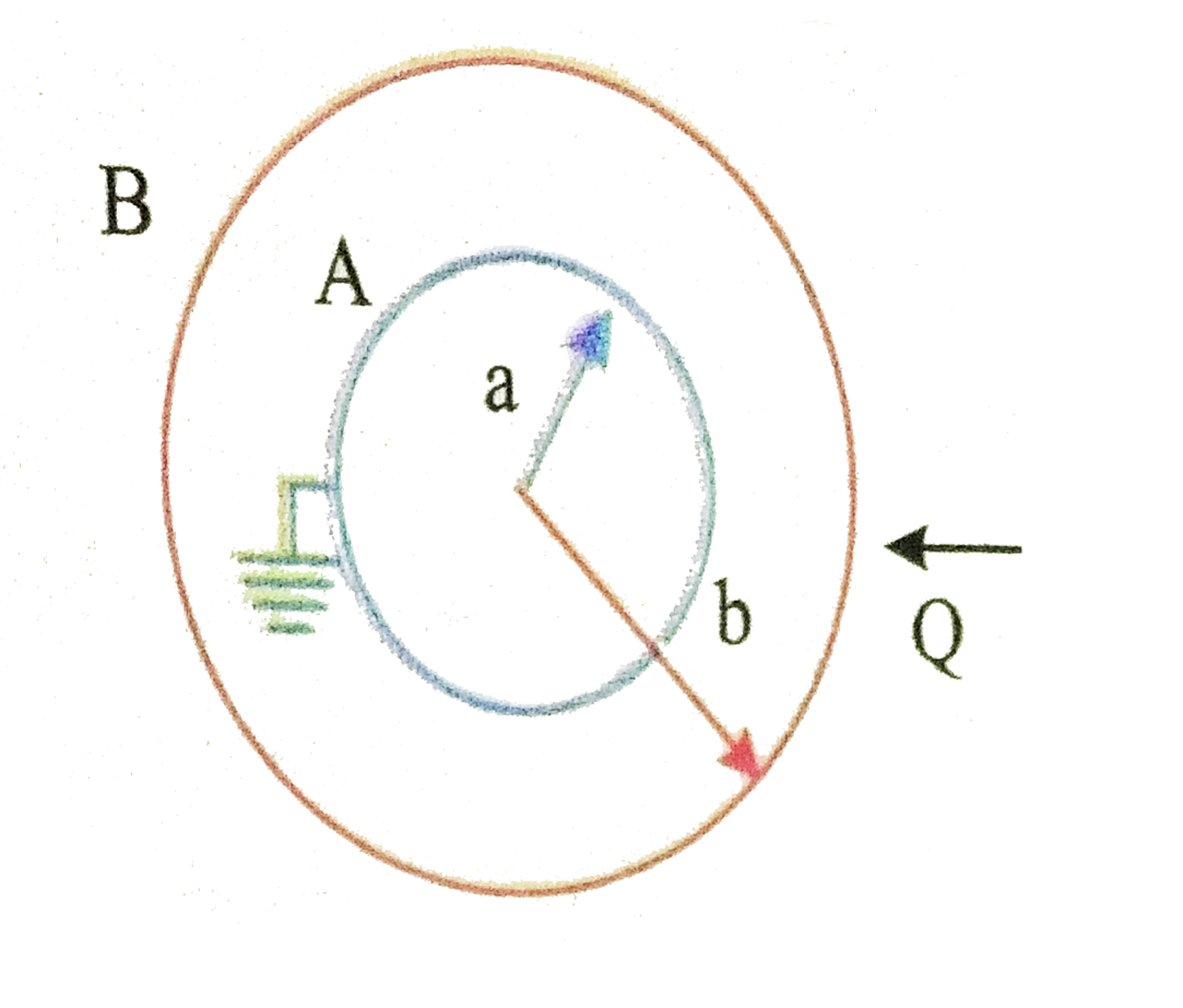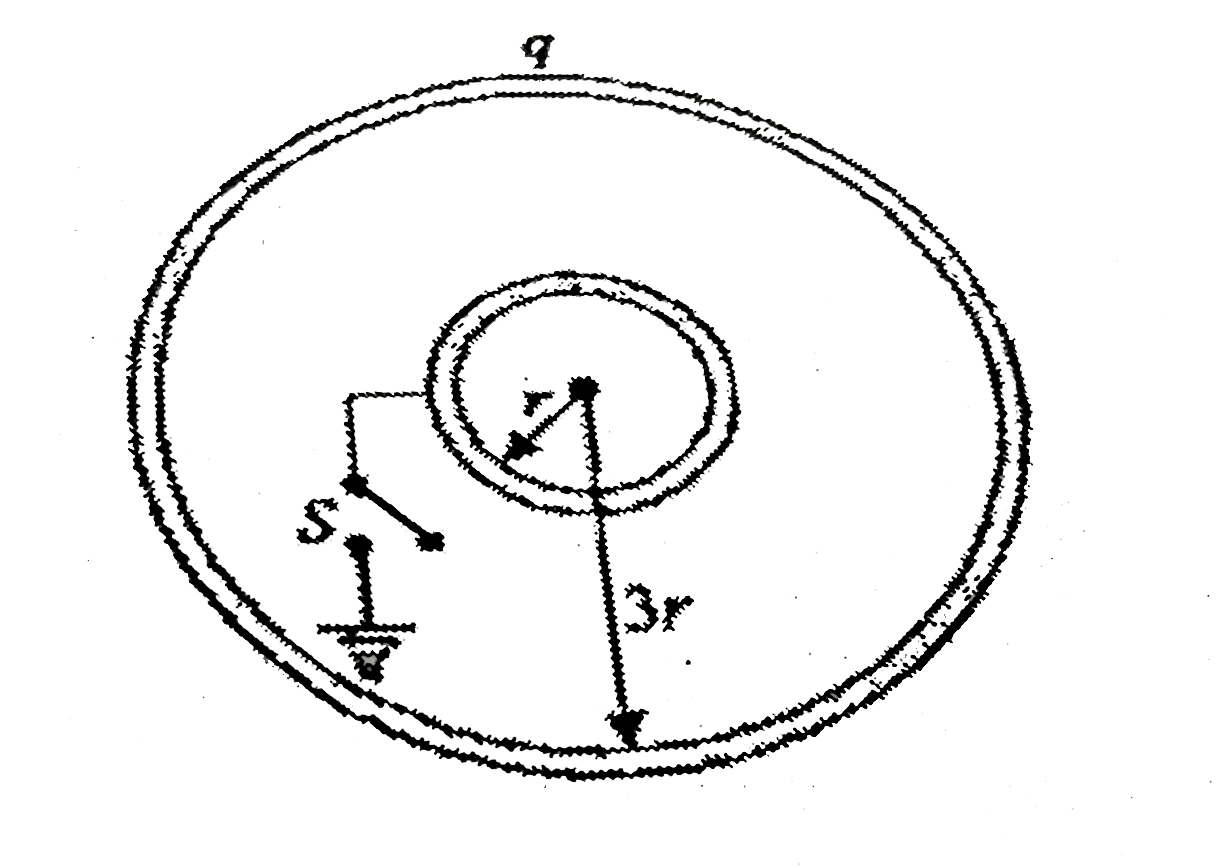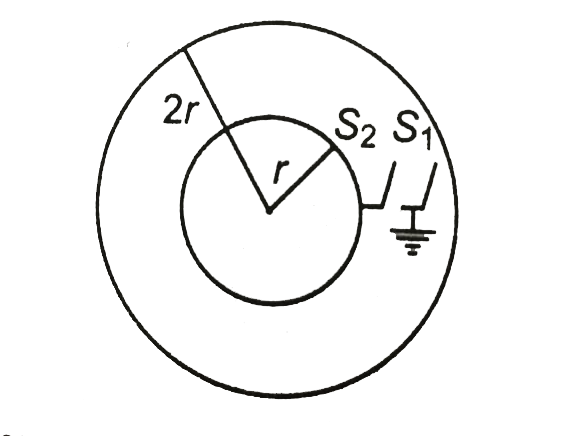There are two concentric metallic shells of radii R and 2R, if outer shell is given charge q1 , then charge on surface of inner shell will be
−q12
−q1
q12
zero
To solve the problem of finding the charge on the surface of the inner shell when the outer shell is given a charge q1, we can follow these steps:
1. Understanding the Setup:
We have two concentric metallic shells. The inner shell has a radius R and the outer shell has a radius 2R. The outer shell is given a charge q1.
2. Properties of Conductors:
In electrostatics, when a conductor is charged, the charge resides on the outer surface of the conductor. This is because the electric field inside a conductor in electrostatic equilibrium is zero.
3. Charge Distribution:
Since the outer shell is charged with q1, this charge will distribute itself uniformly on the outer surface of the outer shell.
4. Induction Effect:
The presence of the outer shell's charge q1 will induce a charge on the inner shell. However, since the inner shell is also a conductor, the charge on its inner surface must adjust to maintain the electric field inside it at zero.
5. Charge on Inner Shell:
The inner shell will have an induced charge on its inner surface of −q1 due to the outer shell's charge. This is because the electric field due to the charge q1 on the outer shell will induce a negative charge on the inner surface of the inner shell.
6. Outer Surface of Inner Shell:
The inner shell must remain electrically neutral overall. Therefore, if the inner surface has a charge of −q1, the outer surface of the inner shell must have a charge of +q1 to balance it out.
7. Conclusion:
Therefore, the charge on the surface of the inner shell is +q1.
Final Answer:
The charge on the surface of the inner shell will be +q1.
We have two concentric metallic shells. The inner shell has a radius R and the outer shell has a radius 2R. The outer shell is given a charge q1.
In electrostatics, when a conductor is charged, the charge resides on the outer surface of the conductor. This is because the electric field inside a conductor in electrostatic equilibrium is zero.
Since the outer shell is charged with q1, this charge will distribute itself uniformly on the outer surface of the outer shell.
The presence of the outer shell's charge q1 will induce a charge on the inner shell. However, since the inner shell is also a conductor, the charge on its inner surface must adjust to maintain the electric field inside it at zero.
The inner shell will have an induced charge on its inner surface of −q1 due to the outer shell's charge. This is because the electric field due to the charge q1 on the outer shell will induce a negative charge on the inner surface of the inner shell.
The inner shell must remain electrically neutral overall. Therefore, if the inner surface has a charge of −q1, the outer surface of the inner shell must have a charge of +q1 to balance it out.
Therefore, the charge on the surface of the inner shell is +q1.
The charge on the surface of the inner shell will be +q1.
Topper's Solved these Questions
Similar Questions
Consider two concentric metalic shell's of radii R and 2R. The inner shell is having charge Q and outer shell is uncharged. If they are connected with a conducting wire. Then,
View SolutionThere are two concentric metal shells of radii r1 and r2(>r1). If initially, the outer shell has a charge q and the inner shell is having zero charge and then inner shell is grounded. Find :
(i) Charge on the inner surface of outer shell.
(ii) Final charges on each sphere.
(iii) Charge flown through wire in the ground.
View Solution
Knowledge Check
There are two concentric spherical shells with inner shell having positive charge q and outer shell having a charge -q. Now outer shell is supplied a charge -2g and inner shell is earthed, Calculate the ratio of initial and final capacities of the system. (If a = 3R, b= 5 R)
 A3/5B3C1D5/3
A3/5B3C1D5/3There are two concentric hollow conducting spherical shells of radii r and R(R>r). The charge on the outer shell is Q. What charge should be given to the inner shell, so that the potential at a point P , at a distance 2R from the common centre is zero ?
A−QrRB−QRrC−2QRrD−Q)Consider two concentric spherical metal shells of radii r1 and r2(r2>r1). If the outer shell has a charge q and the inner one is grounded, then the charge on the inner shell is
A−r2r1qBzeroC−r1r2qD−q
There are two concentric conducting spherical shells of radii 10 cm and 20 cm. The outer shell is charged to a potential of 50esu while inner shell is earthed. The charge on outer shell is
View SolutionConsider two concentric spherical metal shells of radii 'a' and b>a .The outer shell has charge Q but the inner shell has no charge.Now the inner shell is grounded ,This means that the inner shell will come at zero potential and that electric fields lines leave the outer shell and end on the inner shell.(a) Find the charge on the inner shell
Find the potential on outer sphere.

View SolutionFigure - shows two conducting thin concentric shells of radii r and 3r The outer shell carries charge q where as inner shell is uncharged. Find the charge that will flow from inner shell to earth after the switch S is closed.

[+q3 charge will flow inner shell to earth]
View SolutionThere are two concentric conducting spherical shells of radius rA and rB respectively (rB=2rA). If the inner shell is given a charge Q and outer shell is given a charge 2Q, then the potential difference between the surfaces of the shells will be K=14πε0
View SolutionThere are two concentric spherical shell of radii r and 2r. Initially, a charge Q is given to the inner shell and both the switches are open.

If switch S1 is closed and then opened, charge on the outer shell will be
View Solution
